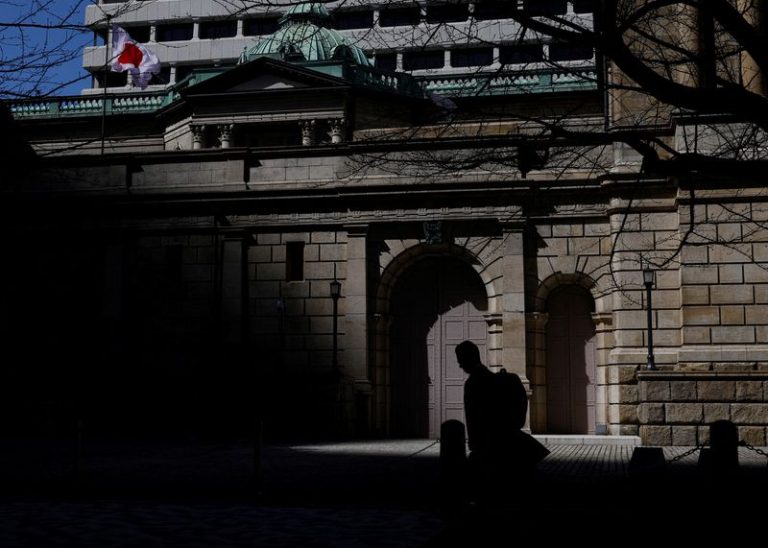TOKYO (Reuters) -The Bank of Japan holds its final policy meeting for the year next week with its decision to be announced just hours after that of the U.S. Federal Reserve’s expected interest rate cut.
Here is a guide on what to expect and why the BOJ’s rate review matters:
IS BOJ GOING TO RAISE INTEREST RATES?
The BOJ ended negative interest rates in March and raised its short-term policy target to 0.25% in July. It has signaled readiness to hike again if wages and prices move as projected.
There is growing conviction within the BOJ that conditions for another hike to 0.5% are falling into place. The economy is expanding moderately, wages are rising steadily and inflation remains above its 2% target for well over two years.
But BOJ policymakers appear to be in no rush to pull the trigger with the yen’s rebound moderating inflationary pressure and uncertainty surrounding U.S. president-elect Donald Trump’s policies clouding the economic outlook.
The decision on whether to hike in December, or wait until a subsequent meeting on Jan. 23-24, will be a close call and dependent on how convinced each board member is that Japan will durably hit the bank’s 2% inflation target.
WHAT HAVE BOJ POLICYMAKERS SAID SO FAR?
BOJ policymakers are keeping their cards close to their chests on the timing of the next rate hike. In a recent media interview, Governor Kazuo Ueda said another rate hike was approaching, but gave no clear signs it could come this month.
Dovish board member Toyoaki Nakamura surprised markets by saying he wasn’t opposed to rate hikes, but said the decision on when to raise borrowing costs should be data dependent.
While the BOJ has its eyes set on hiking rates by March, the recent non-committal remarks suggest the BOJ is leaving itself a free hand on the exact timing of the move.
WHEN DO MARKETS, ANALYSTS EXPECT THE NEXT RATE HIKE?
Just over a half of economists polled by Reuters last month expect the BOJ to raise interest rates in December. About 90% forecast the BOJ to have hiked rates to 0.5% by end-March.
By contrast, markets are currently pricing in approximately a 30% probability of a rate increase in December.
HOW COULD MARKETS REACT?
The BOJ’s decision will come hours after that of the U.S. Federal Reserve, which is widely seen cutting rates. The divergence in the two central banks’ rate direction could cause fluctuations in the yen and bond yields.
A rate hike by the BOJ could nudge up the yen. A decision to stand pat may weaken the yen, though its decline may be limited if markets swiftly price in the chance of a January hike.
WHAT ELSE SHOULD MARKETS LOOK OUT FOR?
Regardless of whether the BOJ hikes rates or not, Ueda is likely to offer guidance on the future rate-path and trigger for action at his post-meeting news conference.
If the BOJ keeps rates steady, Ueda may drop hawkish hints to avoid unleashing unwelcome yen falls, and explain key factors it will scrutinise in judging the timing of the rate hike.
By contrast, Ueda may deliver dovish communication if the BOJ were to raise rates to convince markets that it won’t go on auto-pilot and instead tread carefully on further tightening.
Aside from the rate decision, the BOJ will release its findings on the pros and cons of the various unconventional monetary easing tools used in its 25-year battle with deflation, in another symbolic step towards ending its massive stimulus.
The review will conclude that interest rate cuts remain better tools to combat economic stagnation than unconventional measures, such as those taken under former Governor Haruhiko Kuroda’s massive asset-buying programme.
WHAT HAPPENS NEXT?
If the BOJ hikes rates, it will likely stand pat at least until April, when it publishes fresh quarterly projections that extend through fiscal 2027 for the first time.
A decision to stand pat will shift market attention to key data and events leading up to the January meeting.
The BOJ may also drop hints on its policy intention at Ueda’s speech to business lobby Keidanren on Dec. 25 and Deputy Governor Ryozo Himino’s public appearance on Jan. 14.
The BOJ’s quarterly report on regional economies, likely due before its Jan. 23-24 meeting, will give board members more clarity on whether wage hikes are broadening nationwide.

